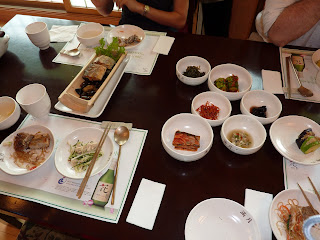Our topic for class yesterday was bullying, and was the first time we experienced a cultural difference on how to approach this topic in schools. Both the Koreans and the Americans were extremely surprised to hear how the other country handles bullies in the schools. Americans work to help victims and improve the attitudes and behaviors of the bullies themselves through group counseling, guidance curriculum, and other prevention/intervention techniques. However, in Korea, the victims of bullying are usually asked to transfer schools. Although some group counseling has proven effective in helping victims feel connected to other victims, the most popular solution to bullying is to ask the victim to leave the school. Victims are thought to disrupt the harmony within the classroom, thus the fault of bullying tends to lie with the victim (so, for example, the victim has some sort of personality defect that is disrupting the class harmony and thus causing the other students to bully him or her). The classroom is considered a family (as is the nature of collectivistic cultures like Korea), and the disruption of this family atmosphere is considered extremely aversive. Teachers in Korea are very intelligent, highly respected, and represent a population that never experienced bullying during their school years. Therefore, it hard for them to relate to students who are bullied. School counseling is a relatively new occupation in Korea (it started around 2006), so Korean school counselors recognize this problem and are working towards trying new interventions to amend this problem.
We had a traditional Korean lunch with the faculty of Korea University's College of Education. This was the first restaurant that required us to take off our shoes before entering. The food was interesting, beautiful, and never ending. It is amazing how spicy the food is here, yet drinks are not a main component of a meal (which made for lots of laughs and watery eyes). We realized how often we take for granted the little things in America...like the lack of fish bones (filet) and the word boneless (experiences of Elizabeth and Jana respectively). We enjoyed the company very much, and it was nice to hear a familiar American southern accent (our new friend John Marshall, a KU faculty member from Chattanooga, TN).
After class, we took a tour of Deoksu Palace. This palace was called "Geumnae" which means forbidden palace, and served as the King's residence starting in 1567. King Seonjong was the main King who lived here. He is well known for inventing the sun-dial, water clock, and the Korean alphabet known as "Hangul". His picture is also on the Korean currency "won".
 Jana's presentation
Jana's presentation Traditional Korean dessert. It's rice in sugar water. We realized later that you are supposed to drink it...not eat it with a spoon. Ah cultural differences...
Traditional Korean dessert. It's rice in sugar water. We realized later that you are supposed to drink it...not eat it with a spoon. Ah cultural differences... The markers represent where each level of citizens would stand and then bow to the king. The front markers are for the most prominent, and the lower class citizens were in the back.
The markers represent where each level of citizens would stand and then bow to the king. The front markers are for the most prominent, and the lower class citizens were in the back. These bowls were filled with water because there was a superstition that if a ghost was behind you and you looked in the water, the ghost would see it's ugly reflection and run away!
These bowls were filled with water because there was a superstition that if a ghost was behind you and you looked in the water, the ghost would see it's ugly reflection and run away!












